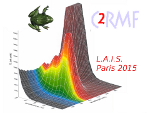Introduction: Shellmounds are found in large number along the Southeast and Southern Brazilian Coast. Their sizes range from about 1 up to 25 meters altitude and from 2 up to 5 meters width. As to their origin there is no unique definition. Originally, it was supposed to be due to sea shore inhabitants that threw remains of shell fish bones in the course of long rivers. More recently, some authors claimed the shellmounts were made as burial site for some people.
Florianopolis Island, Capital of the Santa Catarina (SC) State, is located in Brazil South and it is an island. Around 50 sites containing shellmounds were foundon it, most of them are medium and small sizes, containing organic particles, whole or fragmented shells and quartz grain with sediments.
Experimental: Samples of shellmound material from two sites, Ponta das Vigias (PV) and Canto dos Araçás (CA), located in SC State, were collected for dating. The samples were taken from base (B), “middle” point (B), and close to the top (T) of each shellmound.
Initially, an aliquot of samples were washed in solutions of H2O2(20%v/v), HCl(conc.), and HF (28%v/v). H2O2 solution eliminates organic material and dark particles reducing almost 85% of the total sample aliquot. Since shells are basically calcite, leaching with HF and HCl promotes its dissolution. At the end, only remains a very small portion of sediments. The chemically treated samples were then sieved to retain grain sizes ranging between 0.080 and 0.180 mm diameter. Thermoluminescence (TL) and EPR were used for the accumulated dose (Dac) evaluation using the additive method. SAR protocol was applied in the OSL technique, however, only T sample was studied by this strategy.
In order to be feasible age determination, two data are need the accumulated dose and the annual dose (Dan). There are several methods to calculate Dan, in this study the Ikeya [9] tables 4.3 and 4.4 of (1993, pp 109 e110) were used, however for applying these tables U, Th and K concentration are fundamental. U, Th and K concentrations were obtained by ICP-MS (Inductively Coupled Plasma Mass Spectrometry, Elan 6100 Perkin Elmer) analysis. To be possible these analyte determinations, around 50mg of each sample was digested with microwave-assisted technology (DGT 100 plus, Provecto Analitica) using an acid mixture (3 HNO3 (conc.):1.5 HF(conc.)). The ICP-MS analytical program was obtained after the dilution of each mono-element SpexÒ stock solution, covering the concentration range from 0.5 to 50 ug/L to Th and U, or 10 to 100 ug/ml for K. A series of four GSJ (Geological Society of Japan) certified reference materials (JG1a, JA-3, JB2 and JB-3) and one soil certified reference material (IAEA Soil 7) were also analyzed to check analytical method performance.
The ages obtained for Ponta da Vigia samples were for T sample: a) by TL 4.89 ± 0.51 years B. P., b) by EPR 5.11 ± 0.55 years B. P., c) by OSL4.21 ± 0.45 years B. P., M sample a) by TL 5.86 ± 0.55 years B. P., b) by EPR 5.29 ± 0.51 years B. P., B sample by TL7.01 ± 0.65 years B. P.
Results: From CA site 3 shells samples were collected besides sediment. Smaller shells were crushed and sieved for TL and EPR analysis. Accumulated doses (Dac) obtained were: Dac (TL) = 36.46±0.31 Gy, Dac(EPR) = 34±0.30 Gy. ICP-MS measurements enable annual dose as 8.34±0.05 mGy/year. Cosmic rays contribution to Dan was 0.015 mGy/year. Ages calculated were 4360.7±0.4 B. P. (TL) and 4073±0.3 B. P. (EPR).
Reference:
Ikeya M., New Applications of Electron Spin Resonance. World Scientific, Singapore, 1993, p 285.
- Poster

 PDF version
PDF version

